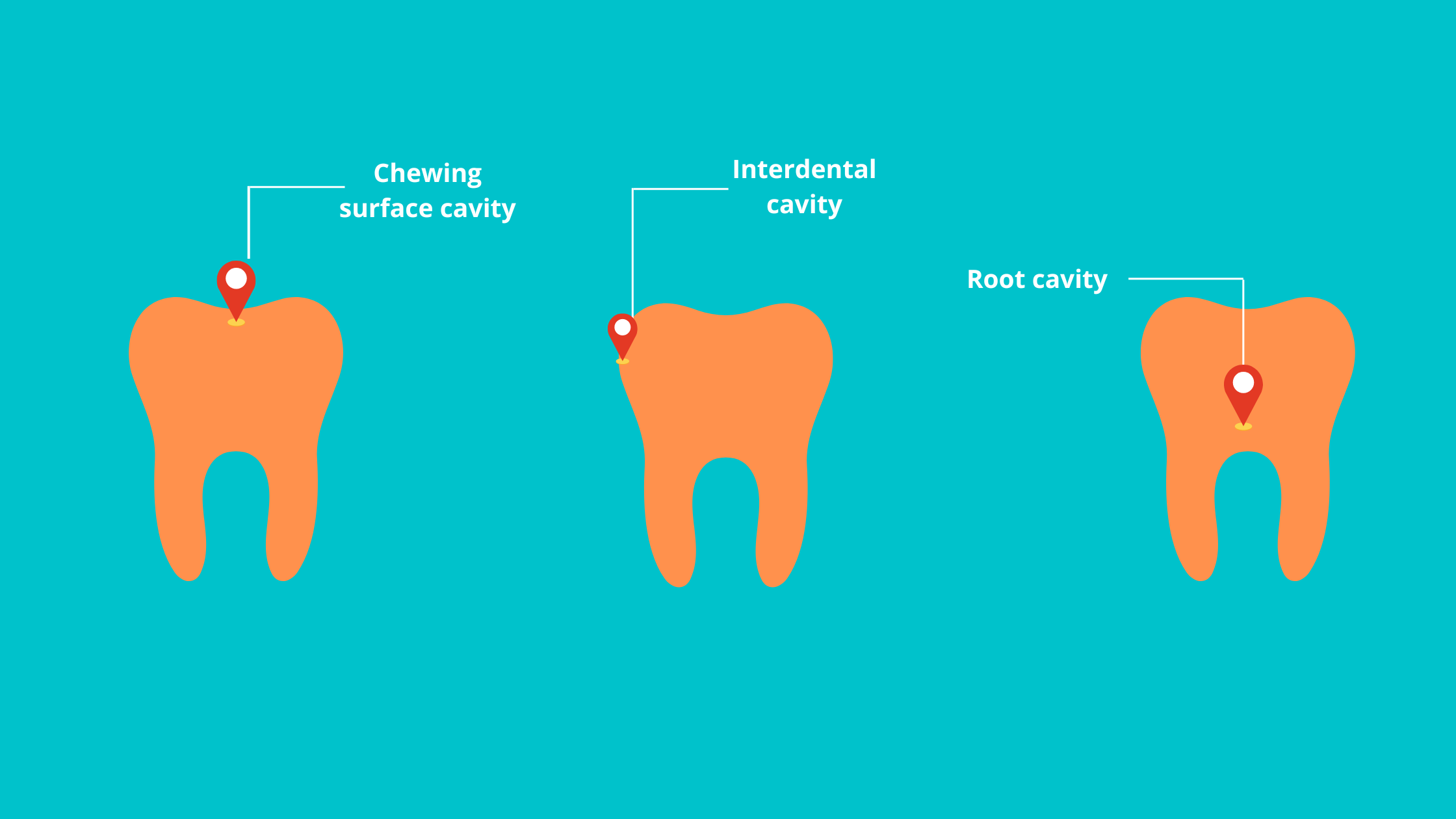3 Types of Tooth Decay That Can Ruin Your Dental Health

Tooth decay is the most common disease in the world.
It starts by damaging the hard outer layers of your teeth—enamel and dentin—and can eventually reach the inner part that contains nerves and blood vessels.

Decay can develop on any surface of the tooth: the top, front, back, near the gums, or between teeth. However, the chewing surfaces and the spaces between teeth are the most prone. These areas often trap more food and plaque, making them favorite spots for cavities.
In this article, we’ll explain the 3 main types of tooth decay and how they progress over time.
In this article
1. Tooth Decay on Chewing Surfaces (Pits and Fissures Decay)
2. Tooth Decay on Smooth Surfaces
3. Tooth Decay Near the Gum Line and Root Decay
4. Why You Should Treat Tooth Decay as Soon as Possible
1. Tooth Decay on Chewing Surfaces (Pits and Fissures Decay)

The top chewing surfaces of your back teeth are the most likely places for decay to start.
Why? These surfaces contain tiny grooves and pits where bacteria can easily get trapped, hide, and grow.
Brushing these areas is also more difficult. The bristles of your toothbrush can’t always reach deep into these small grooves. So, even if you brush thoroughly, some plaque and bacteria might still be left behind—without your notice.
In some people, these grooves are naturally narrower and deeper than normal, which makes the area even more vulnerable to cavities.
The tricky thing about this type of decay is how it spreads. It often progresses in an inverted "V" shape. It starts as a small spot on the surface, but widens as it goes deeper into the tooth.

So what may look like a tiny stain or line from the outside could actually be hiding a much larger problem inside.
How to Prevent Chewing Surface Cavities
The best way to prevent cavities on the chewing surfaces is to keep your teeth clean and plaque-free. Brush twice a day with fluoride toothpaste, and don’t forget to floss daily to remove food and plaque from between your teeth.
Regular dental check-ups are also important. Your dentist may recommend professional cleanings and fluoride treatments, especially if you're more prone to cavities.
Dental sealants are another highly effective option. The procedure involves applying a fluid resin to the grooves and pits of your back teeth to seal them off and to keep out bacteria and plaque.
Sealants are commonly used for children, but adults can benefit from them too.
2. Tooth Decay on Smooth Surfaces

The smooth front and back surfaces of your teeth are naturally less likely to develop cavities. Unlike the grooved chewing surfaces, they aren't the perfect shelter for bacteria to hide and grow.
They are also easier to clean with a toothbrush and are constantly exposed to the cleaning action of saliva.
But that’s not the case for the smooth surfaces between your teeth. These are the second most common spots for tooth decay—right after the chewing surfaces.
The tight spaces between your teeth aren’t exposed to saliva and are harder to clean. Plaque and food can easily build up there, especially if you don’t floss or use an interdental tool regularly.
Cavities between the teeth can be difficult to detect because they’re hidden from view. Often, they don’t become noticeable until the damage is advanced or visible on a dental X-ray.
You might only realize there’s a problem when it starts to hurt or when a visible hole or discoloration appears.
3. Tooth Decay Near the Gum Line and Root Decay

It's not common for tooth decay to start in the smooth areas near the gum line. So when decay does appear there, it’s often a sign that something is off.
This area is easy to clean and constantly exposed to saliva, which naturally washes away bacteria. If decay forms here, it often means that you're at a higher risk—and there may be cavities developing in other areas as well.
Root decay is another type of cavity, and it's more common in older adults.
That’s because aging often brings dental issues like tooth wear, dry mouth, and receding gums. When the gums pull back and expose the roots of your teeth, those roots become vulnerable to the acids in your mouth.
Tooth roots aren’t built to handle this environment. Without the gum’s protection, they become more likely to decay due to the following reasons:
- The root surface is rougher, making it difficult to clean and easier for plaque and food debris to stick.
- Roots don’t have enamel, the hard outer layer that protects the rest of the tooth. Decay can spread through them about twice as fast.
- Roots are more fragile, with fewer minerals and tiny pores that lead directly to the tooth’s nerves.
Because root decay progresses quickly and is close to the nerves, it needs to be treated as soon as possible to avoid complications, like infections or even tooth loss.
Why You Should Treat Tooth Decay as Soon as Possible
The reason is simple: tooth decay doesn’t go away on its own. If left untreated, it will only get worse.The only stage where decay can be stopped—or even reversed—is when it’s still in the enamel, the outer layer of your tooth. At this point, it often appears as a white or brown chalky spot.
But once the decay breaks through the enamel and creates a hole (a cavity), you can’t treat it at home. The damaged part needs to be removed and filled by a dentist.
The earlier you catch and treat tooth decay, the easier, faster, and less expensive it will be.
Waiting until the damage becomes extensive is never a good idea.